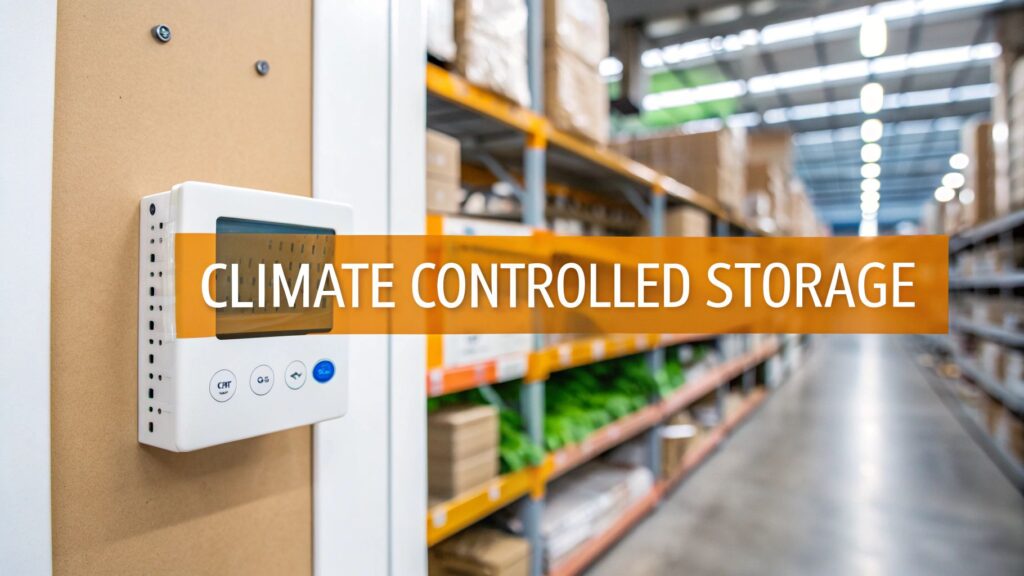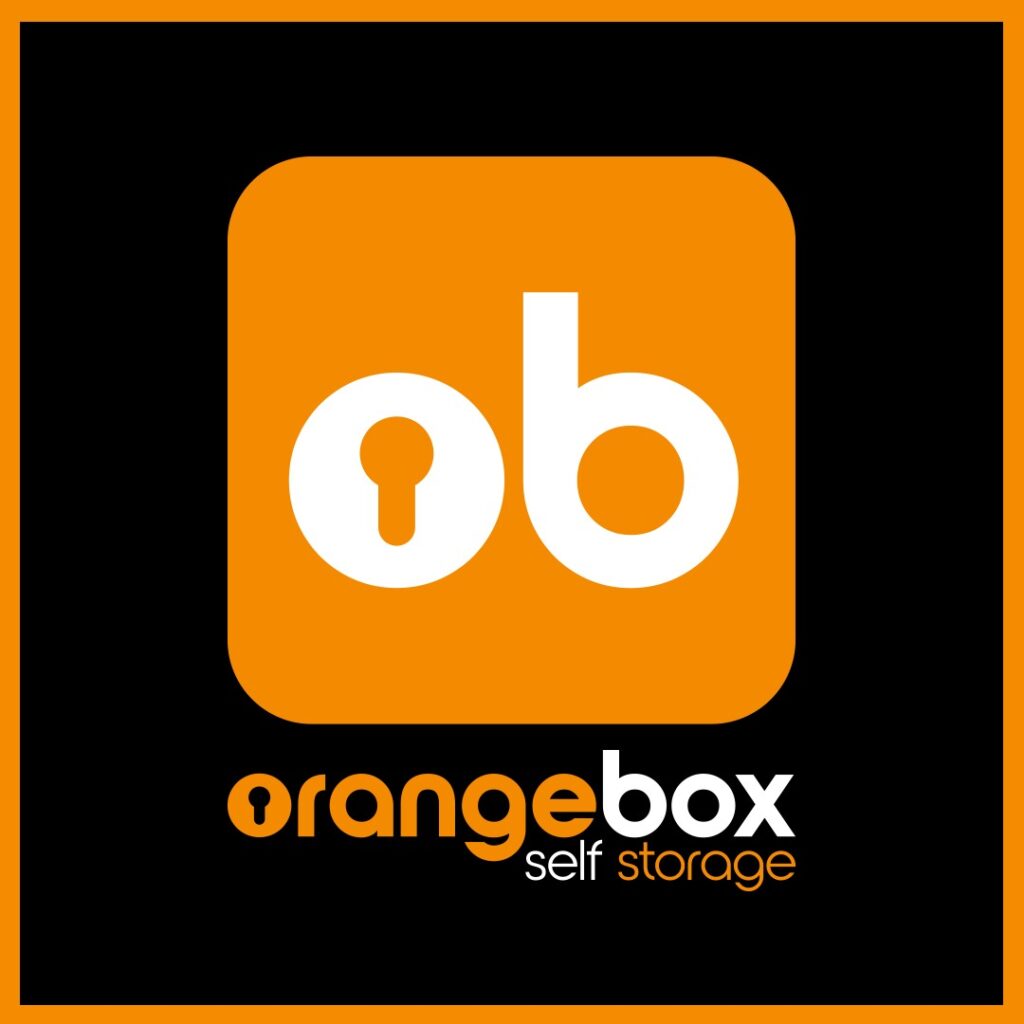Imagine trying to keep your most precious belongings safe in a standard garage, exposed to the blistering heat of summer and the damp chill of a British winter. Now, picture them in an environment more like a museum archive, perfectly preserved. That's the essential difference climate controlled storage brings to the table, maintaining a consistent temperature and humidity to shield your sensitive items from harm.
What Exactly Are Climate Controlled Storage Units?
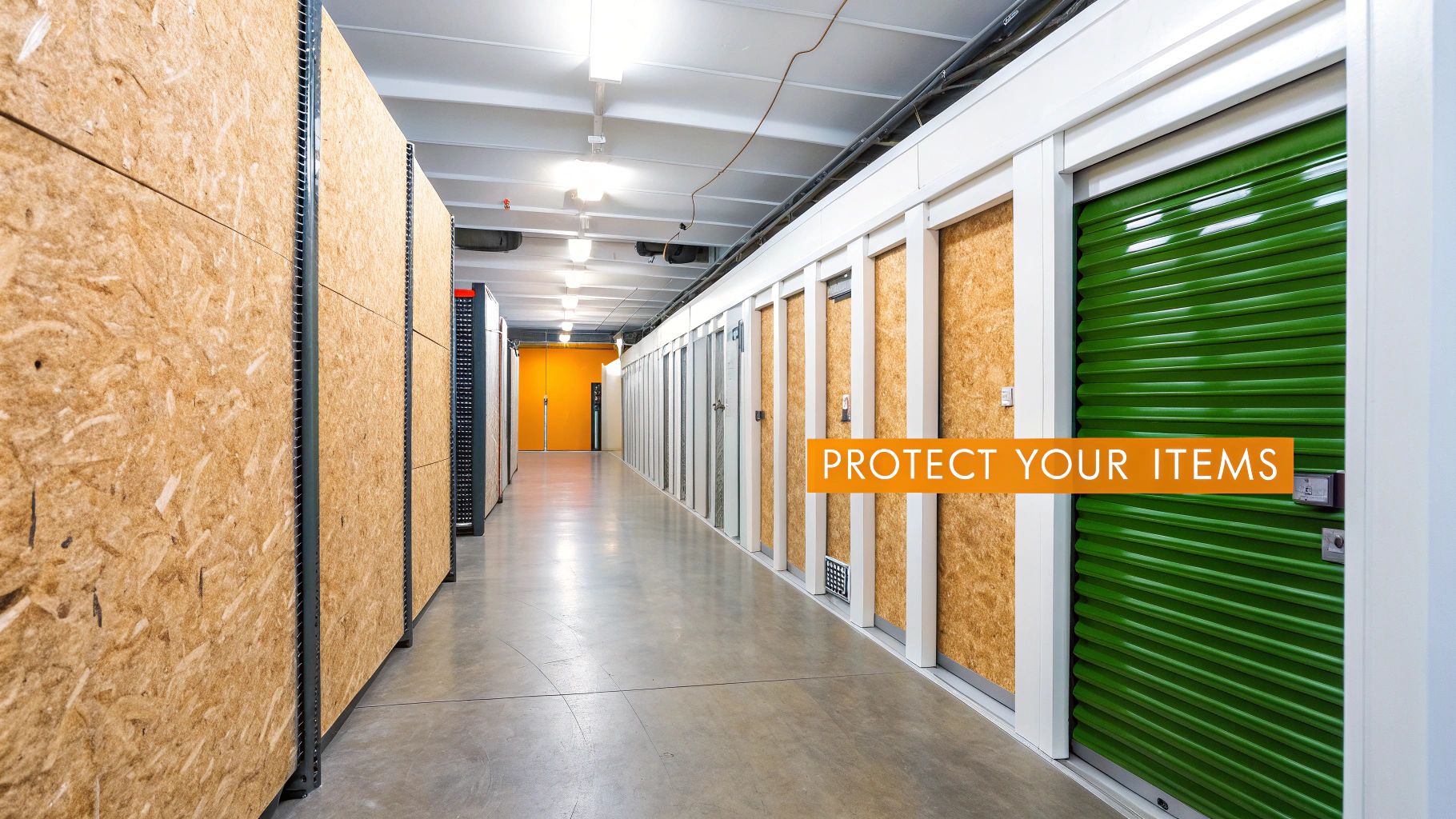
When you hear "climate control," it's easy to think of simple air conditioning. But true climate controlled storage units offer a much more sophisticated level of protection. These are fully enclosed, indoor spaces fitted with specialised heating, ventilation, and air conditioning (HVAC) systems designed for one purpose: creating total stability.
Let's break it down with an analogy. A standard storage unit is like a garden shed, bearing the full brunt of the elements. A temperature-controlled unit is a step up—think of a car with the air-con on. It can cool things down, but it does little to combat moisture.
A climate controlled unit, however, is like a modern, well-insulated home. It actively manages both temperature and humidity to create a predictable, stable environment where your belongings are safe from environmental damage.
The Two Pillars of Climate Control
The main goal is to prevent the wild environmental swings that can wreak havoc on your possessions. This is done by carefully managing two key factors:
- Temperature Regulation: These units typically keep the temperature within a steady range, usually between 13°C and 26°C (55°F and 80°F). This stability is crucial for preventing materials from expanding and contracting, which leads to cracked wood, warped plastics, and ruined photos or documents.
- Humidity Management: This is the game-changer, and it's often overlooked. By keeping relative humidity levels low and stable (generally below 55%), these units stop dampness in its tracks. This actively prevents the mould, mildew, rust, and corrosion that are a serious threat in the UK's climate.
A common mistake is thinking temperature control and climate control are one and the same. The secret weapon of climate control is humidity management. It offers a complete defence against moisture-related damage like mould and rust, which temperature control alone can't do.
To help you see the difference clearly, here’s a quick comparison.
Climate Control vs Standard Storage At a Glance
This table breaks down the key distinctions between a standard unit and a climate controlled one, so you can see exactly what you're paying for.
| Feature | Standard Storage Unit | Climate Controlled Storage Unit |
|---|---|---|
| Environment | Exposed to outdoor temperature and humidity fluctuations. | Stable, regulated indoor environment. |
| Temperature | Varies with the seasons (can be very hot or cold). | Consistently maintained between 13°C – 26°C. |
| Humidity | Not controlled; susceptible to dampness and moisture. | Actively managed to stay below 55%. |
| Protection | Basic shelter from rain and wind. | Protects from mould, mildew, rust, warping, and pests. |
| Best For | Durable items like garden tools, bicycles, plastic boxes. | Sensitive items like wood furniture, electronics, art, documents. |
Ultimately, a climate controlled unit offers an unparalleled level of protection.
The Value of a Stable Environment
It’s no surprise that this superior level of protection comes at a higher price. The investment in advanced HVAC systems, heavy-duty insulation, and constant monitoring means these units are a premium service.
In the UK, you can expect to pay between 20% and 50% more for climate controlled storage compared to a standard unit. You can explore more about how these units are priced and operated on kuboid.co.uk. For many people, though, that extra cost is a small price to pay for total peace of mind, acting as an insurance policy against irreversible damage to irreplaceable or high-value belongings.
Why the UK Climate Demands Better Protection
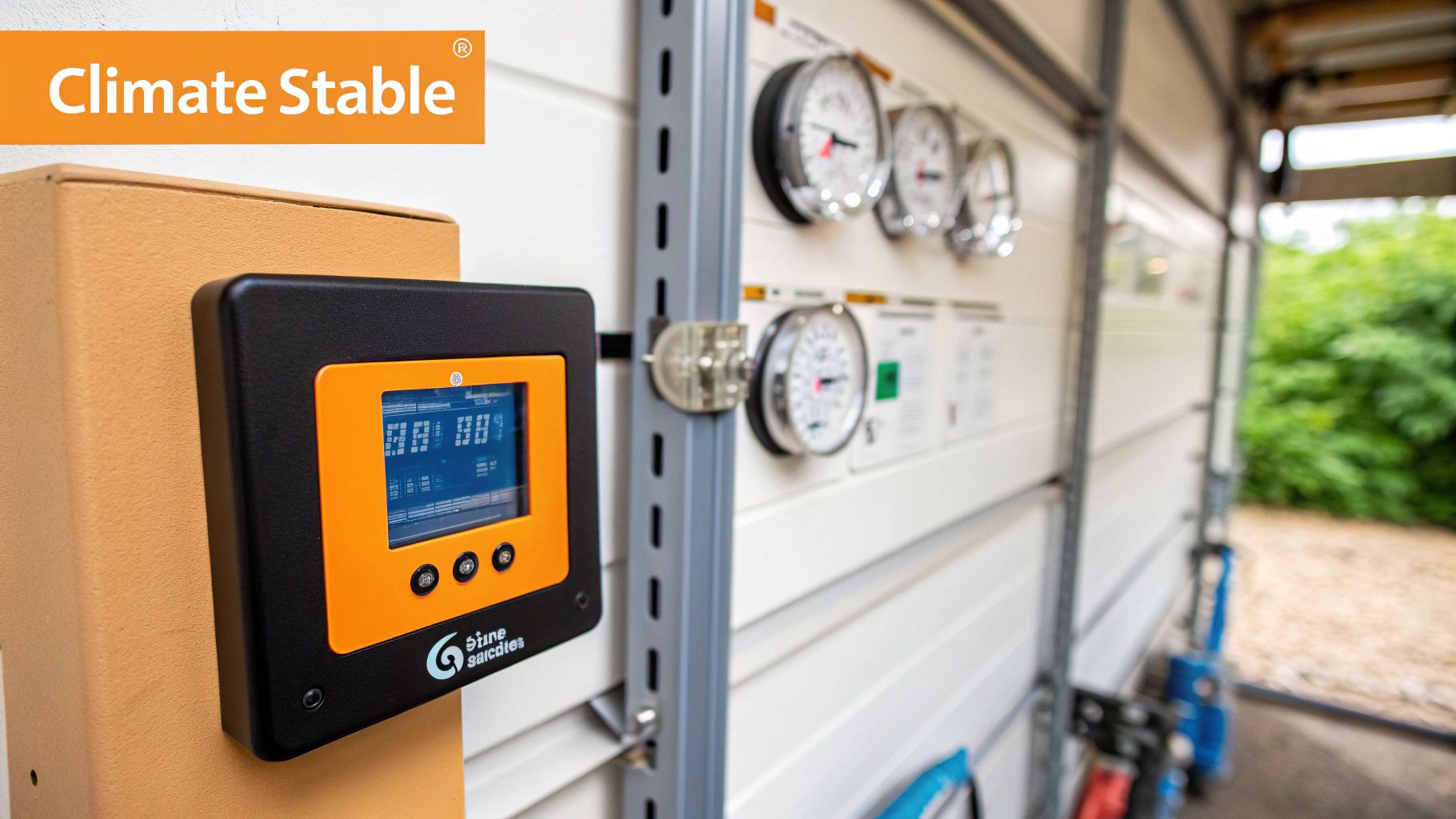
We all know the British weather is famously unpredictable. A mild but damp winter can easily roll into a surprisingly humid summer, creating a real headache for anything you have in storage. It’s these constant, often subtle, shifts in temperature and moisture that make standard storage units a risky choice in the UK.
Think of a typical, non-climate-controlled unit as just a metal box. When a warm, humid day is followed by a cool evening, the air trapped inside that box cools down. This change forces the moisture in the air to turn into liquid condensation, which then settles on every single surface. It's a quiet, creeping process that can be incredibly destructive over time.
This isn’t just about keeping things from getting a bit damp; it's about stopping the slow decay that can ruin your most valued possessions before you even realise it's happening.
The Science of Damp and Decay
The number one enemy of stored items in the UK is humidity. High levels of moisture in the air create the perfect breeding ground for a whole host of problems. Many homeowners are already familiar with understanding the challenges of damp proofing in homes, and this same logic applies to your stored belongings, highlighting why specialised climate controlled storage is so crucial for sensitive items.
The risks are varied and significant:
- Mould and Mildew: Fabrics, upholstered furniture, and paper-based items like books and documents act like sponges in a damp environment. They can quickly develop mould, leading to permanent staining and musty odours that are nearly impossible to get rid of.
- Warping and Cracking: Wooden furniture is especially vulnerable. It absorbs moisture from the air, causing the fibres to swell. As conditions dry out, the wood contracts, leading to ugly cracks, warped surfaces, and doors or drawers that no longer fit properly.
- Corrosion and Rust: Metal objects, from the delicate components inside your electronics to the legs of a vintage table, will slowly corrode and rust when exposed to persistent moisture. This kind of damage is often irreversible.
A sudden summer heatwave after a rainy spell can be just as damaging as a cold, damp winter. The rapid expansion and contraction of materials can degrade sensitive electronics, fade artwork, and turn old photographs brittle.
A Practical Defence Against the UK Weather
For certain items, investing in climate controlled storage units isn't a luxury; it’s a necessary defence. Imagine a classic wooden dining set that’s been passed down through your family. In a standard unit, just a few seasons of typical UK weather could cause its joints to loosen and its finish to peel.
Similarly, a treasured collection of vinyl records could warp beyond repair in a summer heatwave, while sensitive business electronics could fail due to moisture-related circuit damage. For these kinds of items, the slightly higher cost of climate control is a sensible investment. It acts as an insurance policy against the slow but certain damage caused by the UK's unique and often unforgiving weather, ensuring your belongings stay in the same condition as the day you stored them.
Which Items Justify Climate Controlled Storage?
So, is paying extra for climate control really worth it? The short answer is: it depends entirely on what you’re storing. Deciding isn't just about the extra cost; it's about understanding which of your belongings are vulnerable. For some things, a standard unit is a risky gamble against permanent damage.
Think about it this way: garden tools or your patio set? They're built to handle the elements. But many of your most expensive or sentimental possessions are far more delicate. The key is to weigh up both the financial and emotional value of what you're putting away.
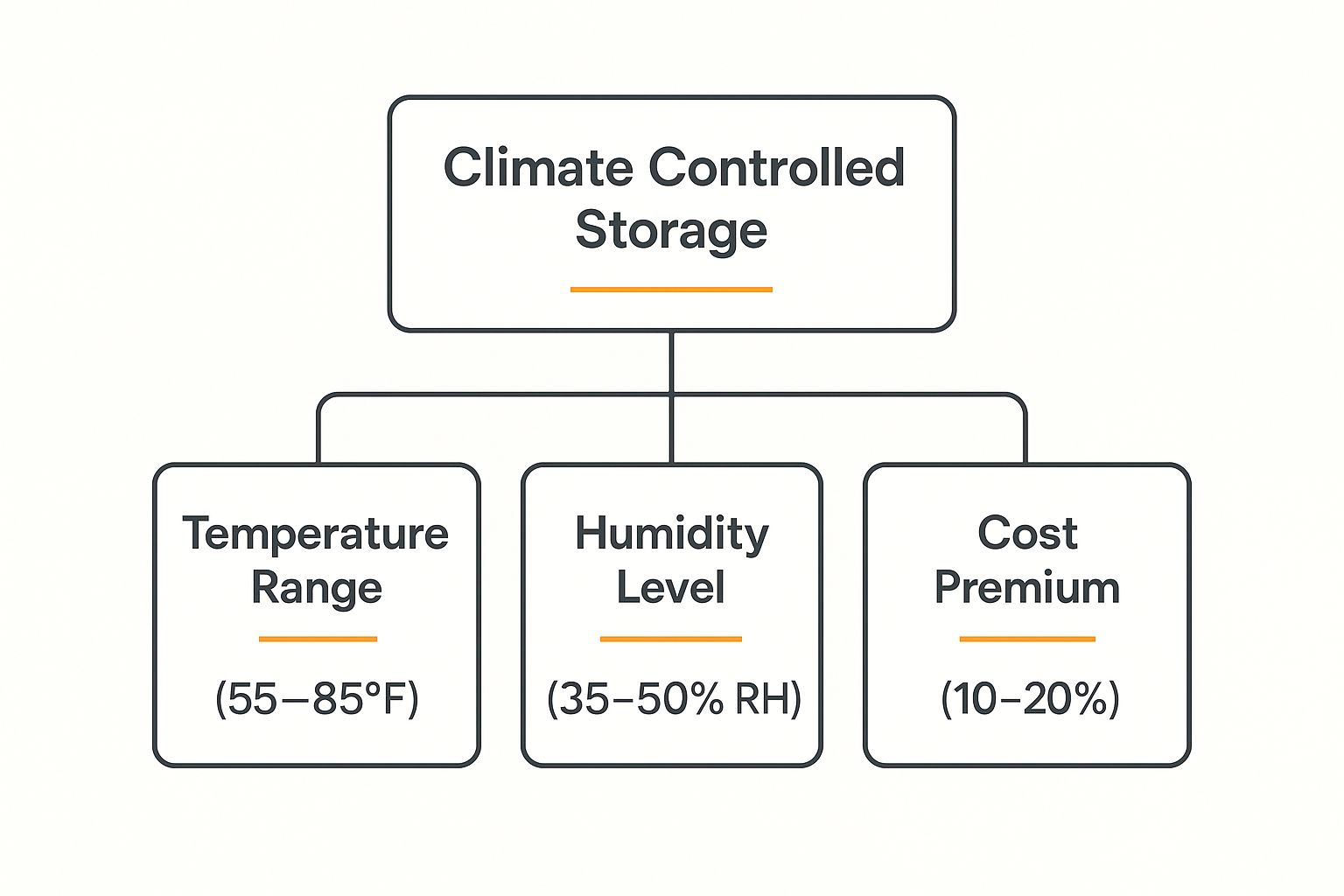
As you can see, these units are all about maintaining a precise balance. For certain items, that consistent environment isn't a luxury—it’s a necessity.
Wooden and Leather Furniture
Wood and leather are two materials that really don't get on with the UK's damp climate. Wood is a natural material, meaning it absorbs and releases moisture from the air around it. This constant "breathing" causes it to swell and shrink, which eventually leads to cracking, splitting, and warping. That antique dining table or family heirloom wardrobe can be ruined.
Leather has a similar problem. High humidity is a breeding ground for mould and mildew, which can permanently stain and eat away at the material. If your furniture has real value, either in pounds or in memories, climate-controlled storage units are the only way to properly preserve them.
Electronics and Media
Your modern gadgets are packed with tiny, sensitive parts that moisture just loves to destroy. Humidity causes corrosion on circuit boards and other metal components, which can lead to short circuits and total failure. Storing a computer, TV, stereo, or camera gear in a standard, damp unit is simply asking for trouble.
The same goes for your physical media collections:
- Vinyl Records: Can easily warp in the heat, rendering them completely unplayable.
- DVDs and CDs: The delicate layers can separate or degrade in extreme temperatures.
- Cassette Tapes: The magnetic tape can turn brittle or, even worse, stick together.
The internal workings of electronics are surprisingly fragile. A device might look perfectly fine on the outside, but hidden moisture damage can render it useless. For your tech, climate control is non-negotiable.
Artwork, Antiques, and Collectibles
When you’re storing items with high financial or historical value, you need the highest level of care. Paintings, for example, can suffer from cracked paint or a sagging canvas due to fluctuating humidity. Antiques, which have already survived for decades or even centuries, are often incredibly fragile and can be quickly damaged by unstable conditions.
It’s a similar story for delicate collectibles. Something like a paper money collection needs very specific environmental conditions to stop it from degrading over time. If you're curious, you can learn more about how to store paper money collections safely.
Important Documents and Photographs
Paper is one of the most vulnerable materials you can put in storage. Photos and important documents will turn yellow, become brittle, and fade when exposed to heat and humidity. Ink can run and pages can stick together, potentially destroying irreplaceable records like birth certificates, business archives, or cherished family photo albums.
For these kinds of essential items, choosing the right protection is absolutely critical, especially if you need a safe place for them over a long period. Our guide on https://orangebox-selfstorage.co.uk/long-term-storage-in-derby-safe-reliable-and-future-proof/ offers more insight into keeping your most important possessions secure for the future.
How to Choose the Right Climate Controlled Facility
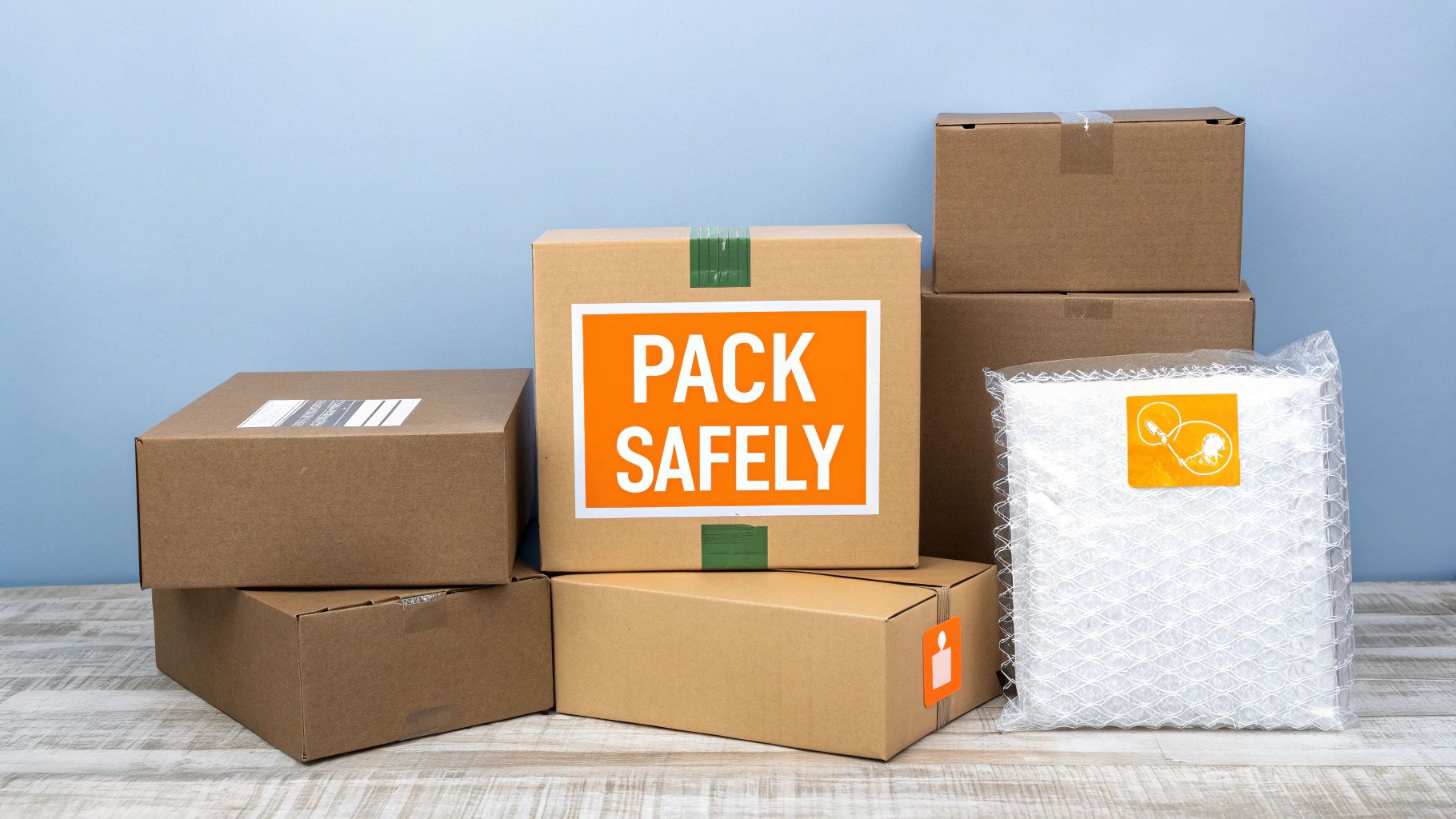
Knowing you need one of these specialised units is the first step, but finding the right one is where the real work begins. Not all climate controlled storage units are created equal, so a bit of detective work is essential to make sure you’re getting the protection you’re paying for.
Think of it like choosing a babysitter for your most precious belongings. You wouldn’t just hire the first person you meet without asking a few questions first. You need to properly vet a storage facility to confirm its systems are reliable and that its promises will hold up.
It all starts by digging into the specifics. A reputable facility should have no problem being completely transparent about its environmental controls.
Ask the Right Questions
Before you commit, get a list of critical questions ready to ask the facility manager. Their answers will tell you a lot about the quality of their operation and whether it’s the right choice for your needs.
Here are a few key questions to start with:
- Temperature and Humidity Range: What specific temperature and humidity range can you guarantee? A genuine climate controlled facility should give you a precise answer, typically between 13°C and 26°C and below 55% humidity.
- System Reliability: What’s the plan if there’s a power cut? Ask about backup generators and alarm systems that monitor the environment to ensure there are no dangerous gaps in protection.
- Security Protocols: Beyond the climate, how secure is the site itself? Look for essentials like 24/7 CCTV, gated access, and individual unit alarms for complete peace of mind.
A vague answer like, "Oh, we keep it comfortable," is a major red flag. True climate control is based on specific, measurable data, not just a feeling. A professional operator will happily share these details with you.
Do Your Own Research
Don't just take the company's word for it. Read online reviews with a critical eye, and look for any recurring themes related to cleanliness, customer service, or unexpected price hikes. When you're searching for a climate controlled facility, it pays to research and compare your local options to find a provider you can trust. For example, looking at guides to the best storage units in Perth shows how local insights can be incredibly helpful.
The final, and perhaps most important, step is an in-person visit. Walk the corridors, check for any signs of pests or dust, and pay attention to whether the air feels clean and dry. This visit also lets you confirm the unit is genuinely indoors, as some facilities offer different levels of protection. Our guide on indoor vs container storage options can help you understand what to look for.
Demand for high-quality storage varies across the UK, with the strongest growth happening in the South East and North West. This regional demand can affect both availability and pricing, making it even more important to do your homework on local providers. You can read more about these UK self storage trends on storeganise.com.
Breaking Down the Cost of Climate Protection
Let's have an honest chat about the price. It’s true that climate controlled storage units come with a higher price tag than standard options—often costing between 20% to 50% more each month. But if you're just looking at it as an extra expense, you’re missing the bigger picture.
It’s far more useful to see it as an insurance policy for your most valuable or irreplaceable belongings. That higher monthly fee covers the sophisticated HVAC systems, robust insulation, and the constant energy needed to keep the environment perfectly stable. You're investing in active protection, not just passive shelter.
What Factors Influence the Price?
The final cost you see on a rental agreement isn’t just pulled out of thin air. Several key factors determine the monthly rate for a climate-controlled unit, and knowing what they are can help you find the best value for your budget.
- Unit Size: Just like with any storage, the bigger the unit, the higher the price. A careful assessment of how much space you genuinely need will stop you from paying for unused square footage.
- Location: Facilities in prime, city-centre locations will almost always be more expensive than those on the outskirts. If you don’t need daily access, choosing a facility a short drive away can lead to some significant savings.
- Technology and Features: The sophistication of the climate control system itself can also influence the price. Newer facilities with more advanced, energy-efficient technology may charge a premium for their superior reliability and monitoring.
Think of the extra cost as a risk management fee. You're paying a small, predictable monthly amount to eliminate the risk of a huge, unpredictable replacement cost for items damaged by damp, mould, or extreme temperatures.
A Clear Cost-Benefit Analysis
To see if the investment makes sense for you, run a simple cost-benefit analysis. Start by making a realistic list of the items you plan to store and put a rough estimate on their total replacement value. Now, compare that figure to the extra monthly cost of a climate-controlled unit.
For example, if you’re storing antique wooden furniture, a prized vinyl record collection, and important business archives, the potential cost of replacing or repairing them after they've been warped or ruined by damp could easily run into the thousands. Suddenly, the modest monthly premium for climate protection seems like a logical, financially sound decision.
This is especially true when considering long-term storage solutions, where items are exposed to seasonal changes for months or even years. For many people, this simple calculation makes the choice crystal clear, turning the higher price from a burden into a sensible safeguard for the things that matter most.
Common Questions About Climate Controlled Storage
Even once you get your head around what climate controlled storage units are all about, a few questions might still be buzzing around. Let's tackle some of the most common queries with direct, straightforward answers to help you make a decision you feel confident about.
Is Climate Control Really Necessary For Short-Term Storage?
It’s a common myth that short-term storage doesn’t need the same level of care as long-term. But think about it – even a brief stint in a standard unit during a UK heatwave or a particularly damp spell can cause real damage. It only takes a few weeks of high humidity for mould to start appearing on fabrics or for paper documents to start warping.
Put it this way: if your items are delicate enough to be damaged over a year, they’re delicate enough to be ruined by a single, harsh weather event. The length of time you're storing for is often less important than how vulnerable your belongings are. For anything valuable or irreplaceable, climate control offers peace of mind, no matter the duration.
How Is It Different From Basic Air Conditioning?
This is a really important distinction. While both involve cooling the air, a simple air conditioning unit does very little to manage humidity. In some situations, it can even make condensation worse. True climate control is a two-pronged attack on the elements.
A climate controlled unit is like a museum archive—it actively manages both temperature and humidity. This comprehensive approach is what prevents mould, rust, and decay, offering a level of protection that simple air conditioning or heating cannot match.
A facility that only advertises "temperature control" or "air cooling" might shield your items from extreme heat, but it leaves them defenceless against the biggest threat in the UK climate: damp.
Can I Access My Climate Controlled Unit 24/7?
Access hours can vary quite a bit from one facility to another. Because most climate controlled storage units are located inside a main building for better insulation and security, access is often linked to the facility's opening hours. This is a bit different from drive-up container units, which might offer round-the-clock access.
Before you sign on the dotted line, always double-check the specific access hours. Think about your own schedule – if you know you'll need to pop in late at night or early in the morning, this could be a deal-breaker. Many modern facilities offer generous hours to accommodate most people, but it’s never wise to assume.
What Is The UK Self Storage Market Like?
The demand for high-quality storage is definitely on the rise across the UK. The self storage market has grown by 7.2% in available space over the past year, now sitting at a massive 64.3 million square feet. This boom reflects just how important the sector has become, with an industry turnover topping £1.2 billion each year.
Interestingly, indoor units—the typical format for climate-controlled options—make up 61% of all storage solutions available. This growth is also happening alongside a swift adoption of technology, with 68% of operators now using AI systems, likely to help manage environmental controls and improve customer service. To see a full breakdown of these industry figures, you can discover more insights in the latest UK self storage annual report on cushmanwakefield.com.
Are There Any Common Mistakes I Should Avoid?
Yes, absolutely. A few common slip-ups can easily cancel out the benefits of renting a storage unit. One of the biggest mistakes is improper packing – using flimsy boxes or not sealing them correctly can be an open invitation for dust and pests. Another is forgetting to create an inventory list, which can turn a quick trip to retrieve an item into a frustrating treasure hunt.
Proper preparation is the key to a stress-free storage experience. Taking a few extra steps beforehand ensures your belongings stay organised, easy to find, and in perfect condition. You can read through a detailed list of what not to do in our guide on the 8 common storage unit mistakes and how to avoid them. Taking the time to sidestep these errors will make sure you get the most value out of your climate-protected space.
Ready to give your valuable belongings the protection they deserve? At Orange Box Self Storage, we offer secure, reliable, and affordable climate controlled units to keep your items safe from the unpredictable UK weather. Book your unit online in seconds today!

